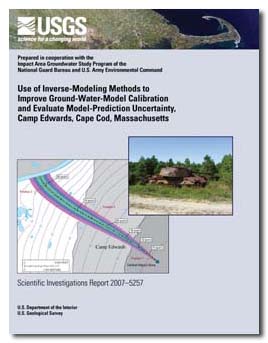Scientific Investigations Report 2007–5257

ABSTRACTHistorical weapons testing and disposal activities at Camp Edwards, which is located on the Massachusetts Military Reservation, western Cape Cod, have resulted in the release of contaminants into an underlying sand and gravel aquifer that is the sole source of potable water to surrounding communities. Ground-water models have been used at the site to simulate advective transport in the aquifer in support of field investigations. Reasonable models developed by different groups and calibrated by trial and error often yield different predictions of advective transport, and the predictions lack quantitative measures of uncertainty. A recently (2004) developed regional model of western Cape Cod, modified to include the sensitivity and parameter-estimation capabilities of MODFLOW-2000, was used in this report to evaluate the utility of inverse (statistical) methods to (1) improve model calibration and (2) assess model-prediction uncertainty. Simulated heads and flows were most sensitive to recharge and to the horizontal hydraulic conductivity of the Buzzards Bay and Sandwich Moraines and the Buzzards Bay and northern parts of the Mashpee outwash plains. Conversely, simulated heads and flows were much less sensitive to vertical hydraulic conductivity. Parameter estimation (inverse calibration) improved the match to observed heads and flows; the absolute mean residual for heads improved by 0.32 feet and the absolute mean residual for streamflows improved by about 0.2 cubic feet per second. Advective-transport predictions in Camp Edwards generally were most sensitive to the parameters with the highest precision (lowest coefficients of variation), indicating that the numerical model is adequate for evaluating prediction uncertainties in and around Camp Edwards. The incorporation of an advective-transport observation, representing the leading edge of a contaminant plume that had been difficult to match by using trial-and-error calibration, improved the match between an observed and simulated plume path; however, a modified representation of local geology was needed to simultaneously maintain a reasonable calibration to heads and flows and to the plume path. Advective-transport uncertainties were expressed as about 68-, 95-, and 99-percent confidence intervals on three dimensional simulated particle positions. The confidence intervals can be graphically represented as ellipses around individual particle positions in the X-Y (geographic) plane and in the X-Z or Y-Z (vertical) planes. The merging of individual ellipses allows uncertainties on forward particle tracks to be displayed in map or cross-sectional view as a cone of uncertainty around a simulated particle path; uncertainties on reverse particle-track endpoints—representing simulated recharge locations—can be geographically displayed as areas at the water table around the discrete particle endpoints. This information gives decisionmakers insight into the level of confidence they can have in particle-tracking results and can assist them in the efficient use of available field resources. |
For additional information contact: Part or all of this report is presented in Portable Document Format (PDF); the latest version of Adobe Reader or similar software is required to view it. Download the latest version of Adobe Reader, free of charge. |
Walter, D.A., and LeBlanc, D.R., 2008, Use of inverse-modeling methods to improve ground-water-model calibration and evaluate model-prediction uncertainty, Camp Edwards, Cape Cod, Massachusetts: U.S. Geological Survey Scientific Investigations Report 2007–5257, 57 p., available online at https://pubs.usgs.gov/sir/2007/5257.
Abstract
Introduction
Purpose and Scope
Site Description and History
Hydrogeology of the Camp Edwards Area
Geologic Setting
Hydrologic Setting
Methods of Analysis
Numerical Ground-Water-Flow Model
Regional Model Design
Modifications to the Regional Model
Representation of Parameters
Incorporation of Observed Heads and Flows
Use of Inverse Methods to Improve Model Calibration
Evaluation of Model Sensitivity
Formulation of the Least-Squares Objective Function
Heads and Flows
Improvement in Calibration
Optimal Parameter Estimates
Precision of Parameter Estimates
Modification to the Model Framework
Advective-Transport Observations
Limitations of Analysis
Evaluation of Model-Prediction Uncertainty
Forward Particle Tracking
Reverse Particle Tracking
Summary and Conclusions
Acknowledgments
References Cited